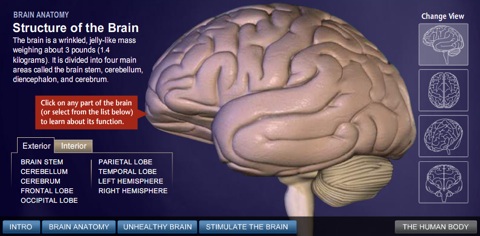Ever wondered how the human brain works (or doesn't work, as the case may be!) Here's a great FREE guide!
 Wednesday, January 30, 2008 at 8:11PM
Wednesday, January 30, 2008 at 8:11PM I came across this great resource from National Geographic. It is a free introduction to the workings of the most complex of human organs, the brain.
Of course, while this will tell you all about neurons, dendrites, and neural connections, it cannot account for the jump from biological, electrical and chemical functioning, to the mystery of human consciousness! That is something that requires a little more research, thought, AND will be the topic of a new book I have coming out towards the end of 2008 that is based upon my doctoral research! So, watch this space!
Here's the resource (found here):
 National Geographic has a quick and helpful interactive introduction to the human brain, explaining in simple terms the brain's anatomy, some common diseases, and also which parts of the brain are lit up by smells, light, sound, romance, and other stimuli. From the site:
National Geographic has a quick and helpful interactive introduction to the human brain, explaining in simple terms the brain's anatomy, some common diseases, and also which parts of the brain are lit up by smells, light, sound, romance, and other stimuli. From the site: The brain's nerve cells are known as neurons, which make up the organ's so-called "gray matter." The neurons transmit and gather electrochemical signals that are communicated via a network of millions of nerve fibers called dendrites and axons. These are the brain's "white matter."LinkThe cerebrum is the largest part of the brain, accounting for 85 percent of the organ's weight. The distinctive, deeply wrinkled outer surface is the cerebral cortex, which consists of gray matter. Beneath this lies the white matter. It's the cerebrum that makes the human brain—and therefore humans—so formidable. Whereas animals such as elephants, dolphins, and whales have larger brains, humans have the most developed cerebrum. It's packed to capacity inside our skulls, enveloping the rest of the brain, with the deep folds cleverly maximizing the cortex area.
The cerebrum has two halves, or hemispheres. It is further divided into four regions, or lobes, in each hemisphere. The frontal lobes, located behind the forehead, are involved with speech, thought, learning, emotion, and movement. Behind them are the parietal lobes, which process sensory information such as touch, temperature, and pain. At the rear of the brain are the occipital lobes, dealing with vision. Lastly, there are the temporal lobes, near the temples, which are involved with hearing and memory.




Reader Comments (1)
hai Forster how r u...? nice information abt human brain
thanks
Ranga